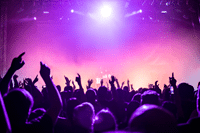Mouse-eared hats are all the rage at Disneyland. They’re offered in a wide variety of colors and styles, and countless visitors—from toddlers to tech founders—can be seen sporting these zany headpieces.
When handed out in Anaheim, mouse ears are magical. But if they’re handed out in, say, the garment district in Manhattan—they’re mortifying. What can this bizarre little quip teach event marketers? Location and context make all the difference.

We all tend to agree that location is the single most important element of a campaign. What we don’t all agree on, however, is how to find the right location for our events.
Get “In” With the Crowd
Your gut might tell you that any crowded area with tons of foot traffic will do the trick. A state fair, for example, is full of people from all walks of life. Surely, some attendees will happily stop by your booth and check out what you’re offering.
But let’s be real here: Do you really think any person at that state fair is interested in discussing insurance premiums over a paper plate of delicious funnel cake? No, they’re there to have fun, play games and win prizes. Unless your booth is offering one of those things, you’re not going to achieve the event engagement results you’re after.
Eighty-five percent of companies believe participation is the most important criteria to measure an event’s success—and this hinges upon a brand’s ability to catch consumers when they’re in the right state of mind.
Consider these three elements when aiming to hit the context jackpot with your next experiential campaign:
1. Timing Even the perfect event in the perfect location needs to be executed at the right time. As the ecclesiastical 1960s pop song goes: “To everything … there is a season.”
For example, if you’re offering soda samples outside a large office building, doing it during the morning rush would be a tough sell. Workers will probably already have travel mugs in hand full of their preferred sources of caffeine. However, if you offer the same experience eight hours later, a post-work pick-me-up would be a welcome addition to their commutes.
You need to think through when consumers would normally engage with the experience you’re offering. Plan the event around that time to boost event engagement.
2. Layout Layout is the location within the location. Your event site needs to be small enough so that it doesn’t interfere with normal traffic patterns, but large enough to give customers breathing room.
If you are set up near a gym, for example, consider that people will be carrying bags and tennis rackets though the area. The last thing you need is attendees accidentally whacking each other with workout gear as they crowd around your display.
Another thing to consider is that 74% of consumers say they are more inclined to buy a product after engaging with it at a marketing event. If you are setting up an experience at a retail outlet that offers your product, make sure attendees can easily place your item in their shopping carts immediately after sampling it. Don’t put your table in the deli section if you’re handing out chocolate; put it right next to a dazzling display of inventory customers can grab while you’re still fresh on their taste buds.
Did you stage a killer event or experience? Enter your campaign into the 2017 PRO Awards by March 17 (late deadline March 31).
3. Appearance Event attendees aren’t psychic. Even if they’re in the perfect mindset for your experience, you still need to craft a campaign that grabs their attention and draws them in.
Going back to an earlier example, state fairs are full of flashing lights, funhouse mirrors, dancing clowns and various loud noises. Setting up a boring, meek, nondescript experience in this setting will get you nowhere. You need to make yourself seen, heard and smelled in order to drive the participation you seek.
Create signage with big, bold lettering that can be seen from afar, and once you engage attendees’ senses with the sizzle of your steak, your enthusiastic team of brand ambassadors can jump into action and close the deal.
A customer’s mindset is a funny thing. As we learn from studying Anaheim’s mouse ear phenomenon, the same product can hit consumers in dramatically different ways depending on the context of the engagement.
Feel free to test out this theory. Hand out mouse-ear hats at your next big client meeting, and see how it goes.
Steve Randazzo is the founder and president of Pro Motion Inc.
Related articles:
Planning a Brand Event? 6 Ways to Hit a Home Run
The Marketing Wizardry of Harry Potter: The Exhibition
NASCAR CMO Jill Gregory on Challenges to Keep Loyal Fans



